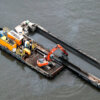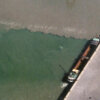Remediation dredging is the name given to clean-up operations specifically aimed at removing contaminated sediments that can endanger marine and human life.
Location of contaminated sediments
Contaminated sediments are often found in industrialised countries, where, historically speaking, few regulations for heavy industries were in place. In the last 25 years, environmental regulations have clearly changed. The whole world has become more environmentally conscious. Presently national and international governing bodies have strict legislation about contaminants and their disposal, what is permissible and what is not.
Remediation dredging – sometimes called environmental dredging – helps responsible authorities comply with present environmental standards for the removal of dangerous contaminants. Ultimately, the aim is to improve overall water quality and restore the health of aquatic ecosystems.
Removing contaminated sediments
Removal of contaminated sediments from the waterbed is complex and demands thorough, detailed environmental assessments. Some of the key components to be evaluated when considering dredging as a clean-up method include:
- characterisation of types of sediment
- sediment removal,
- transportation of materials,
- treatment (pre-treatment, treatment of water and sediment, if necessary), and
- disposal (re-use when possible or otherwise confinement).
Site investigations
The characterisation of material to be dredged is always important, but with contaminated sediment the need is heightened. Prior to the start of the operation, a thorough site investigation should evaluate:
- physical, chemical and biological characteristics of the sediment;
- potential dredging methods;
- use, disposal or treatment options;
- potential impacts;
- extent of biological and/or chemical testing; and
- monitoring needs before, during and after the remediation operations.
Specialised techniques and equipment
Remediation dredging must be conducted in a way that minimises the spread of contaminants to the surrounding waters. Efficient coordination of each component is very important for a cost-effective clean-up. In general, fewer sediment re-handling steps lead to lower implementation risks and lower costs.
Remediation dredging also requires dedicated equipment which can dredge in a way that recognises the added hazard of working with contaminated sediments. For instance, remediation dredging techniques aim to achieve a high concentration of dredged sediment with the lowest possible turbidity. Also, the precision with which remediation dredging operations are done is of the utmost importance.
Precision dredging
Precision dredging means that the thinnest layers possible are accurately removed so that the least possible quantities of contaminated material are dredged. In this way, the least possible amount of material will require treatment or disposal. Since treatment of contaminated sediment is costly and secure disposal areas are limited, precision dredging offers a viable solution. On the other hand, dredging precisely means that operational and production rates are lower than for navigational dredging. This increases the time and cost of a project.
Environmental dredgers
That said, remediation dredging is often a necessity and special ‘environmental dredgers’ have been developed to meet these needs. These are often modifications of cutter suction hopper dredgers, backhoes and grabs. Examples include:
- encapsulated bucket lines for bucket chain dredgers;
- closed buckets for backhoes;
- closed clamshells for grab dredgers;
- auger dredgers,
- disc cutters, scoop dredgers and sweep dredgers, all of which are modifications of standard cutter dredgers.
These dredgers also contain advanced positioning and monitoring systems. Other adaptations for remediation dredging are the use of silt screens or air bubble screens. These enclose the area being dredged and prevent sediment from drifting into the surrounding waters.
Although controlling turbidity is always an issue in dredging, remediation dredging makes the need for low turbidity even more pronounced. The development of the so-called “green valve” system for trailing suction hoppers is one way in which turbidity caused by overflow is reduced during the dredging process.
Remediation dredging performs a crucial service by reversing the environmental hazards created by industrialization. Its goal is to decrease environmental and health risks in bodies of water ranging from lakes and rivers to ports and channels. Remediation is a solution toward improving water quality both for people and marine life.














































